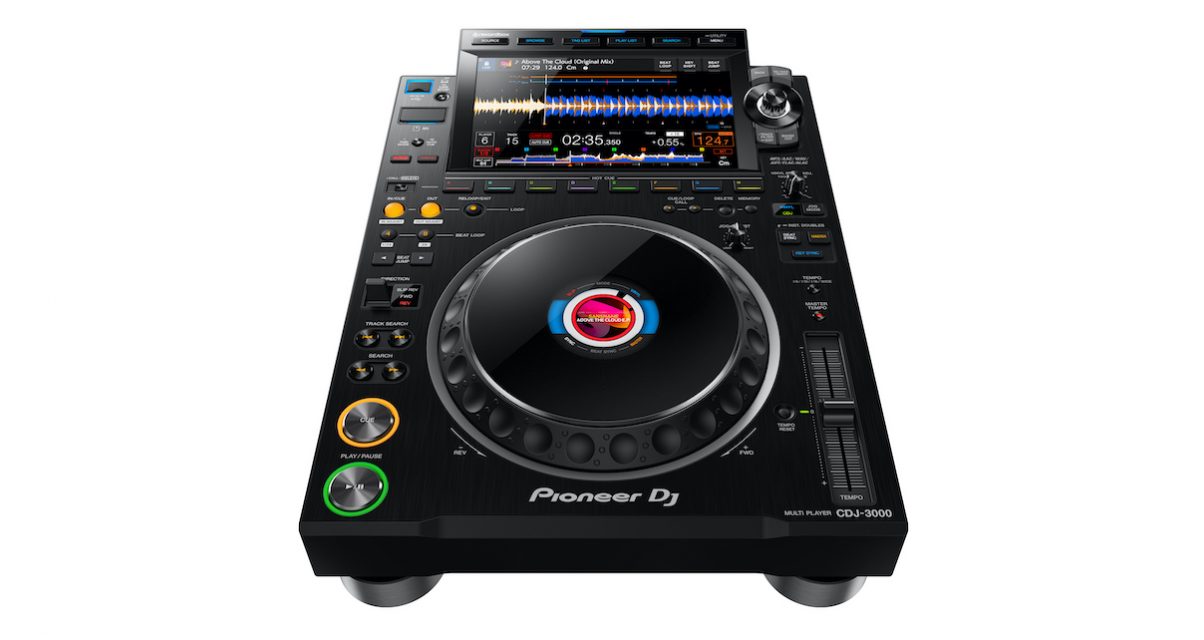The Lowdown
The Pioneer DJ CDJ-3000 is the new flagship in the range, and so needed to deliver something special. By and large, it has. Hugely better screen, improved jogwheels, better hot cues, beat jump, key shift and key sync, innovative track previewing and cueing options – and all powered by an on-board MPU. Sure, it is evolution, not revolution, but that’s what pro DJs, clubs and festivals require – and the potential is there for adding the missing stuff (we’re thinking cloud locker, streaming services, on-board track analysis – some of which have already been added since writing this review) down the line. Pioneer DJ now does need to get its software team focused on those items to keep up with the competition, though.
Don’t have our latest DJ gear guide? Click here to grab your free copy
Video Review
First Impressions / Setting up
The CDJ is 25 years old! DJing has changed beyond recognition since the first top-loading CDJ-500s (yes, I owned a pair back then…), with digital music, laptop DJing, the end of vinyl and CDs as mainstream formats, and the rise of new ways of DJing (such as keymixing) changing the very definition of what DJing is.
Incredibly, Pioneer DJ has had the run to itself, by and large. The only challengers really have been Technics (early on – remember the SL-DZ1200?) and Denon DJ (more persistently, especially recently).

So for the CDJ-3000, what has Pioneer DJ done to keep it up to date? Has it incorporated the kind of features the vast majority of DJs (who use controllers) love and are used to? If so, how has it done this while keeping continuity with the different needs of pro DJs, clubs and festivals? And has Pioneer DJ done enough so the CDJ-3000 can hold its own against the (pretty universally well-received) Denon DJ Prime media players?
Pioneer DJ is calling this “A New Dimension” – is that just referring to the size of the units, or do they really represent a whole new dimension in DJing?
Well, it instantly feels like a CDJ on unboxing. Roughly the same dimensions, actually (it is a little bit deeper, and very slightly wider, but the same height), and everything appears to be in the same place and of the same basic design.
However, you’ll soon spot the differences, even before powering up. The screen is the first thing: It’s much bigger (it’s now 9″), and so dominates the top of the unit in a way the screen of the CDJ-2000NXS2 didn’t; the source buttons have moved from the left-hand side of it, and the four buttons and browse knob have pushed further to the left, occupying the space where the CD eject button was.
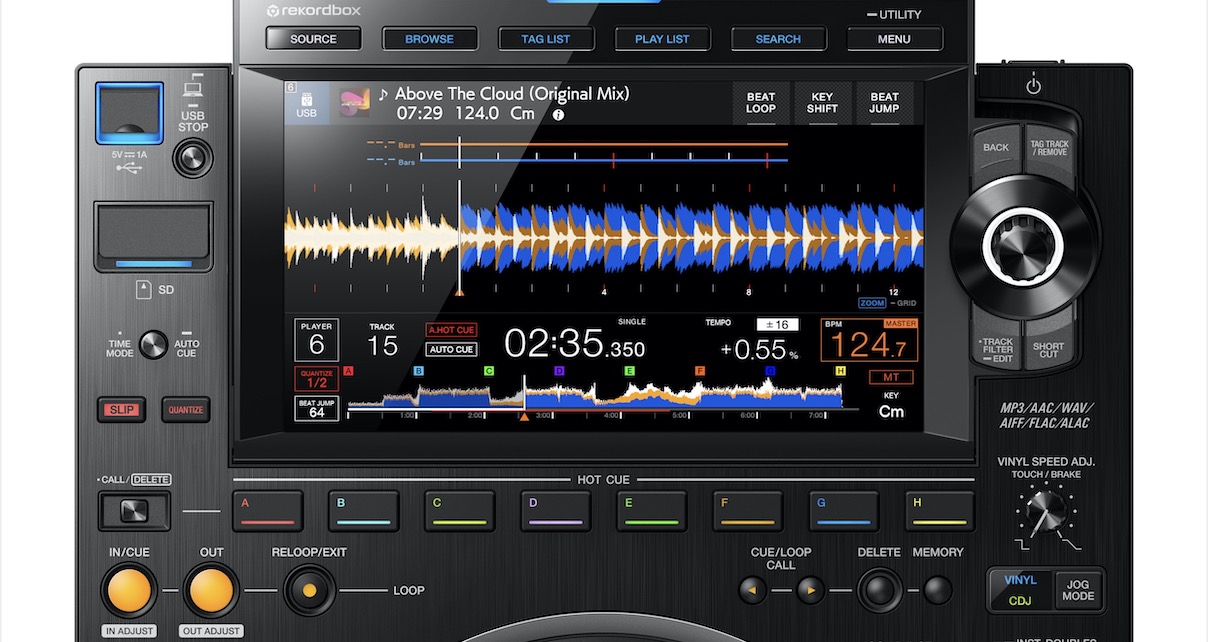
And that’s one of the next things you notice: Despite being called a “CDJ” player, there is no need for that CD eject button, because there is no CD slot! This is now a completely digital player, which can work with SD and USB cards, as well as networked Rekordbox collections, Rekordbox music on an attached smartphone, or as a controller for DJ software (Rekordbox at launch, Serato coming).
The next biggest change is the redesigning of the hot cue buttons, which now appear in a straight horizontal line directly under the screen, and which have doubled in number, to eight. They are still quite small, and still hard plastic, but it’s a big improvement, reflecting the importance of hot cues in DJing as it is done nowadays.
Learn to DJ with ANY gear: The Complete DJ Course
There are lots of other small changes, and features that beg investigation: Beat Jump buttons have appeared above the redesigned FWD/REV/SLIP REV direction rocker; an instant 8-beat loop button joins the 4-beat loop one; Slip mode has moved to top-left where it joins a new Quantize button; there’s a new Key Sync button (much more about this later); and the frankly useless knob for adjusting deck start-up speed has been wisely dropped, to name the most obvious ones.
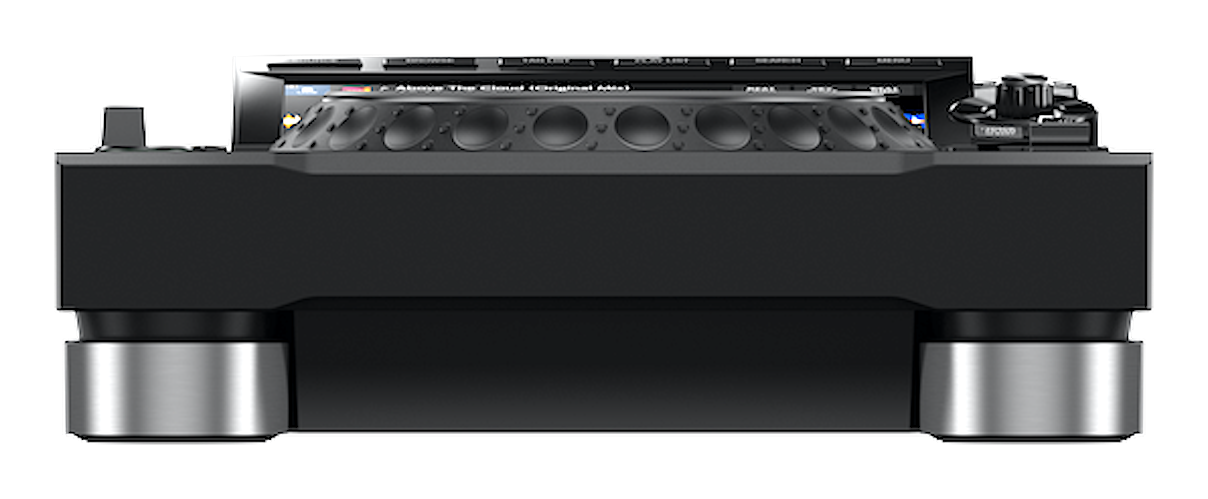
Closer inspection of the unit reveals a subtle but noticeable jump in build quality, too, with a smoother-feeling jogwheel (that nonetheless doesn’t deviate too far from the feel of the previous one), a metal plate covering the whole of the top of the unit, not just the centre area as before, and a locking IEC cable at the back (which otherwise is practically identical in layout and sockets to the previous model).
Set up is the same as the CDJ-2000NXS2: you’ll plug it in to your mixer (Pioneer DJ provides a digital cable as well as RCAs), use the Ethernet port to link it to other players and your mixer, via a switching hub, and you’re good to go with any Rekordbox-analysed music on SD or USB. The other options are available (using LINK to DJ from a laptop Rekordbox library, or full software control – this is a Rekordbox Unlock device) over USB, WAN or WiFi, as long as your switching router has it – there appears to be no built-in WiFi in these units.
In Use
The screen
The screen is definitely what captivates you at first, especially coming from the small, dim, jerkily updating screen on the CDJ-2000NXS2. It is frankly gorgeous. No, it is not glass-topped like that of similarly sized tablet devices (or indeed like that of the Denon DJ Prime players), but it is bright, a decent if not awe-inspiring resolution (1280 x 720), and perfectly smooth scrolling.
In short, it’s a joy to DJ with, and a huge, huge improvement over the screen on the CDJ-2000NXS2. It’s the single biggest visible reason why these players are such a leap forward over their predecessors.
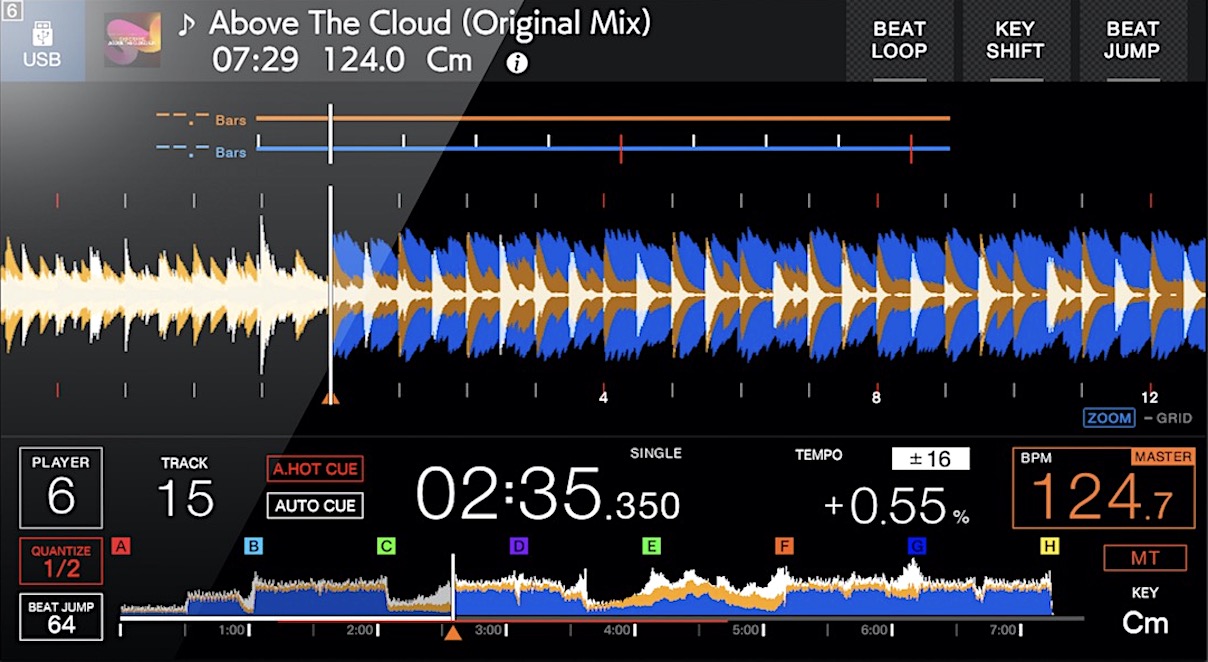
The extra resolution means that not only can you specify more information to be shown when browsing tracks (it’s cool to have artist and title showing for tunes, for instance), but the functionality has been ramped up too, in all kinds of ways, as we’ll see throughout this review. It’s not multi-touch, but at least it does have touch control, and actually on a single-function device like a DJ player, the lack of multi-touch doesn’t actually seem a big omission.
It’s one of the main reasons why DJing on these is a whole lot of fun.
Jogwheel improvements
Overall, Pioneer DJ has walked the line between improvements to the jogwheels and keeping things familiar pretty well here. The jogwheels look and feel similar, barring a very small change to the acrylic top plate, which is now slightly grooved. However, they have less “wobble” and are quieter in use, while still having the mechanical Jog Adjust control for fine-tuning their looseness.
One of the biggest changes to the jogwheels are the internal 3.5″ displays, which are the same as on Pioneer DJ’s DDJ-1000 controller and a vast improvement over the previous model. They still show you track position, also showing hot cue and cue loop positions, and tell you whether or not you have Slip mode on, also giving you a quick status on both Sync and Master deck.

For visual DJs (I’m looking at you, old school vinyl fans), the jogs also display track artwork right there on the player – a nice touch for some, but a game-changer for others.
James Zabiela spoke to us about the jogs specifically, saying he thinks they are by far the best jogwheels on any Pioneer gear, even claiming they have helped him to rediscover scratching rather than relying on the Trans effect! Firm praise indeed…
Loading, searching and playing music
Firstly, let’s get this out of the way: You absolutely still need to analyse your music in Rekordbox before playing it on the CDJ-3000s. There is no on-board analysis of BPM, waveform data, key and so on. This will certainly disappoint some people, and it’s not as if the unit isn’t powerful enough to do it, as it’s actually got more computing power than the rival SC6000 player from Denon DJ. However, that is how it is.
Once you’ve got a properly analysed music collection loaded though, the fun definitely begins.
The buttons for Source (now one button, with selections being made from available sources on-screen), Browse, Tag List (think: prepare window), and the new Play List and Search – along with the Menu button – now appear in a neat row across the top of the screen. (The old “Info” button has moved to the touchscreen on the CDJ-3000.)
There is also a little glowing light here that illuminates in the “colour” of the source selected, and you can assign colours to sources: This is a good way to always know what any particular CDJ-3000 is pulling its music from.
The way all of this works is broadly similar as on previous models, it’s just that with the nicer screen, it feels so much smoother and there is so much more information on view.
Read this next: Best Pioneer DJ Gear 2023
You can still choose how to view your music down the left-hand side of the browse window (by artist, title, playlist, folder and so on), but they are now small icons leaving the rest of the screen free for track info. (Note that you can configure what options you are shown here in Rekordbox before you export your music to USB/SD or connect via LINK.)
What’s more, when you press “Playlist”, ‘Tag List” or “Search”, the categories view down the left-hand side disappears completely, giving you even more screen real estate.
You can sort your music by tapping on column headers, and there is a new, secondary column that is optional. I love this – it brings the screen much more into line with the experience of using software (for instance, I want to see Artist and Title) – but you can equally choose Album or, more usefully, Rating. Would be good to see more options here though – Year and Genre would work for me.
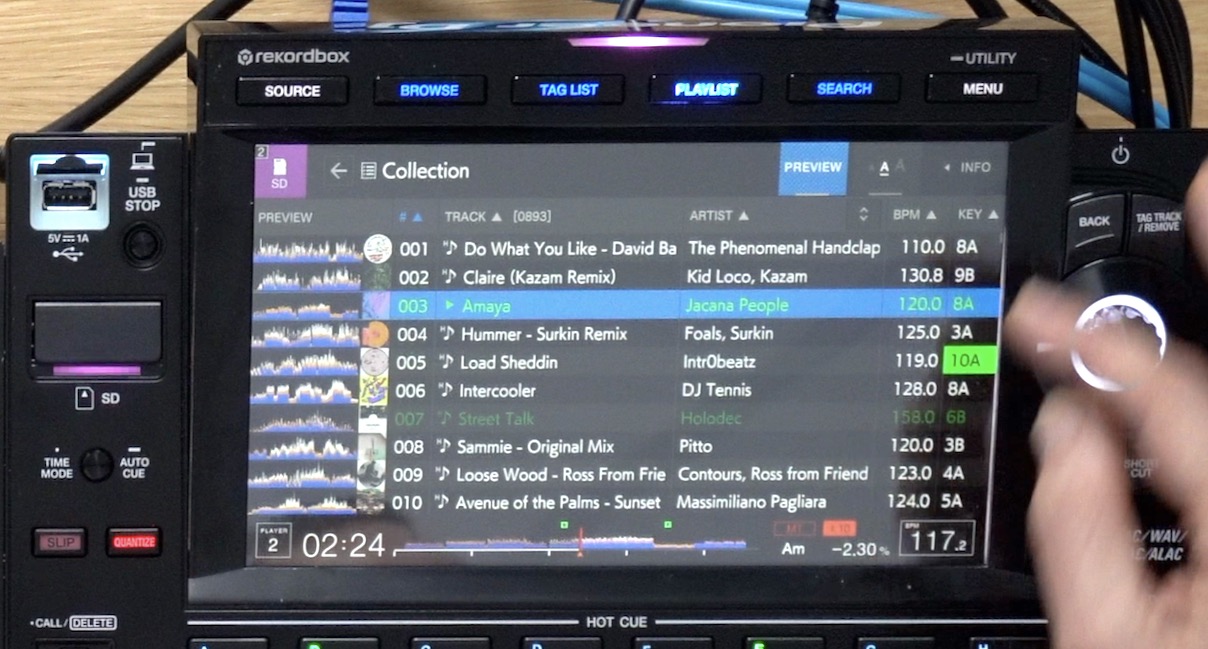
You can long-press the browse knob to quickly sort A-Z or scroll through your selected list page by page instead of track by track.
The Tag List works as before, as a way of preparing tracks you may want to play soon. You touch the “Tag Track” button (top right) to add a track to the tag list, touching the button again to remove a track. When in the Tag list, a long hold on the Tag Track button will remove a track, or tapping on “Menu” will give you options to convert the Tag List into a Playlist, or delete it entirely.
Note the this is the only place in the operating system where you get to make playlists: You cannot rename, organise or further work on your playlists from the CDJ-3000, as you can with Denon DJ’s Prime system.
You can search in the same way as ever, by hitting “Search” to bring up the on-screen Qwerty keyboard. This works nicely with the new additional column, though, and I particularly liked it in conjunction with the Track Preview function, which we’ll get onto in a bit.
The Filter works as before: To filter the tracks being shown to you by BPM, key, colour, rating, tag and so on. The filter edit screen that lets you decide the filter criteria hasn’t changed, and is accessible in the same way (by holding down the button bottom left of the rotary encoder).
Also as before, you can access the Shortcut screen by holding down the bottom-right button under the encoder. The Shortcut window now has extra options, such as the ability to move the playhead further left on the screen (to show you more of the forthcoming audio), adjustment of screen and LCD brightness, and adjustment of the new Beat Jump feature default size (more about Beat Jump later).
Hard to emphasise, though, just how it is all so much more immersive, smoother, information rich and functional – plus, it all feels so much quicker and snappier than before, which is not surprising as the unit has a lot more power inside. More about the significance of that later.
DJing with the new waveforms and beatgrid data
The bigger, better screen makes the waveforms a much more integral part of using the unit than with the CDJ-2000NXS2. You can choose how they look (blue, RGB or the “3Band” appearance from Rekordbox, which shows you each frequency and is very much like the way waveforms are shown on Denon DJ’s players), and as before, you can zoom in or out on the main waveform using the scroll knob.
The lower waveform that shows the whole track is similar to before, but is vastly superior in appearance, also showing the three frequencies if you wish, and benefiting from the better size, resolution and brightness of the screen.
Learn to DJ with ANY gear: The Complete DJ Course
Above the main waveform, though, things have changed. On the CDJ-2000NXS2, you had a choice of beat bars (flashing bars indicating the first, second, third and fourth beats of the bar) or a rudimentary beatgrid of horizontal and virtual lines, showing the current deck and the master deck.
On the new players, though, the old blocky beat marker bars are gone, and instead there is a choice of much-superior beatgrid displays (full width), or a second track waveform. Effectively, this brings parallel waveforms to the CDJ-3000s, giving DJs an intuitive and information-rich way of looking at what’s playing on the current deck and the Master deck on the same screen. A tap of the screen above the main waveform decides which of these is displayed.
Touch Preview & Touch Cue
When used with a compatible mixer (such as the DJM-900NXS2 or the DJM-V10) that has a “Link Cue” button, it is possible to both preview tracks from a browser on any player without loading them, and to “listen ahead” to any track on any player in your headphones, just by touching its waveform.

Let’s look at Touch Preview first. As you can now choose to display waveforms in the browser window, just as you can in Rekordbox, Pioneer DJ has also added the capability to touch the waveform on the screen. The track will then play from the place you’ve touched, directly in your headphones, as long as “Link Cue” is selected on the mixer. This allows you to decide if you want to play a track without loading it first.
Touch Cue is a great new feature that is a little like the “Sandbox” feature in VirtualDJ software. It lets you “listen ahead” to a track you are currently playing in your headphones. You do so by touching the whole track waveform of the playing track. Again, as long as you have “Link Cue” pressed on your mixer, you will hear the track from that point in your headphones, while the audience is hearing the track playing as usual.
This works across all players, so for instance, you could take over from another DJ, line up your first track, then use Touch Cue to listen to how that DJ’s last track is going to end, to figure out the best way to mix out from it.
Both of these features offer genuine innovation, especially Touch Cue, and I can see a lot of DJs taking to them.
Cues, Loops, Loop Roll, Slip & Beat Jump
The new hot cues are an obvious improvement. They are neatly backlit in a more sophisticated way than on the CDJ-2000NXS2, and you can choose to have them individually coloured or all one colour (green). This is useful because if you opt for one colour, then when you save loops to a hot cue slot (by hitting an empty slot while looping), they get saved in a different colour (orange), so if you DJ with saved cues and loops, you may choose to do it this way. You delete hot cues/loops, as ever, by holding the CALL/DELETE button and pressing a hot cue.
Whenever you’re in a mode when they may be useful to you, extra loop buttons appear on the screen, called the “Beat Loop” buttons – a set of eight horizontal buttons ranging from 1/16th of a beat up to 32 beats. Basically you get them whenever you set a manual loop, or trigger a 4-beat or 8-beat loop using the single touch loop buttons. These effectively act like the Auto Loop buttons on DJ controller pads, allowing you to quickly select a different loop length.
Read this next: Complete Guide To Switching From DJ Controllers to CDJs
You can select a second bank of values too, for triplets and odd-number auto loops, which is cool (this is something James Zabiela tells us he uses for big BPM changes, say from house to drum & bass). If you want to bring up Beat Loop at any time, you can tap “Beat Loop” top right on the main screen.
When you press the Slip button to enter Slip mode, a simplified set of the same buttons appears, with no second layer of odd numbered loops, instead running from 1/16th of a beat to 2 beats, with two triplet values too. Effectively this is “Loop Roll”, another of the functions usually assigned to performance pads on controllers and rival systems.

It’s all pretty neatly done, and I prefer it to Denon DJ’s implementation of Slip mode, which bafflingly doesn’t work when you are performing certain actions – Pioneer DJ’s does what Slip mode should, and works whether you’re looping, using cues, scratching, pausing, or anything else.
Beat Jump is a big new feature, and one that many will love. You set the size of the Beat Jump in the Utility menu, and pressing the forward or back Beat Jump button jumps you forward or back by that exact number of beats, expressed as a multiplier or fraction of a single beat (so 1/2, 1, 2, 4, 8, 16, 32, or 64 beats).
If you are in a loop when you hit Beat Jump, the whole loop jumps. This is better than Denon DJ’s Loop Jump, which annoyingly only works when jumping forwards; on the Denon DJ system, jumping backwards leaves the loop where it is and jumps you out of it until you reach it again, which isn’t what Loop Jump should do in my opinion.
Here is as good a place as any to point out that Quantize now gets its own button, right next to the Slip button, and all your cues, loop start/end points and so on will snap to grid whenever Quantize is on; you can set its value in the Utility menu.
Key, Key Shift & Key Sync
For our audience, keymixing is one of the huge things that digital DJing has ushered in that has utterly transformed DJing, so I am going to spend some time explaining the innovation here on the CDJ-3000, which is considerable.
CDJs have for a while now had “Master Tempo” – the equivalent of “key lock” on other systems, It locks the pitch as you change the tempo, making it possible to slow down and speed up tracks without them sounding too low or high, and thus enabling easy keymixing. But the CDJ-3000 takes it further – further than any other system, software or otherwise. In short: We love it.
Before we move on to the advanced key features, let’s just point out a big new change for DJs who enjoy the idea of keymixing but do not what to apply any algorithms to their tracks: Now, if you slow down or speed up a track with the tempo sliders, the indicated key on the screen will change, telling you the “new” key of that track at the different tempo. A feature for the purists (+/-4% is about a semitone, if you’ve never tried to keymix like this before…).
Read this next: The Ultimate Guide To Keymixing For DJs
So assuming you’re down with the idea of altering pitch in real time to keymix, and especially if you’ve experimented with “key sync” features on other systems, you may have noticed that existing system have a problem. If you hit “key sync”, they may move your track a laughable number of notes up or down to get a match, way past what could possibly sound OK.
And here’s the crazy thing: That needn’t be the case!
Many years ago, when researching the music theory behind harmonic mixing for our How To Master Keymixing course, I realised that the purveyors of DJ keymixing systems had got it wrong. They say that you should only keymix between tracks in the same key, the dominant key, the sub-dominant key, or the relative key. (If you were using Camelot, if your track was 8A, that’d be tracks in 7A, 8A, 8B or 9A.) But actually, it’s also fine to use 7B and 9B, too – the relative keys of the dominant key and subdominant key, too – or moving “diagonally” on the wheel.
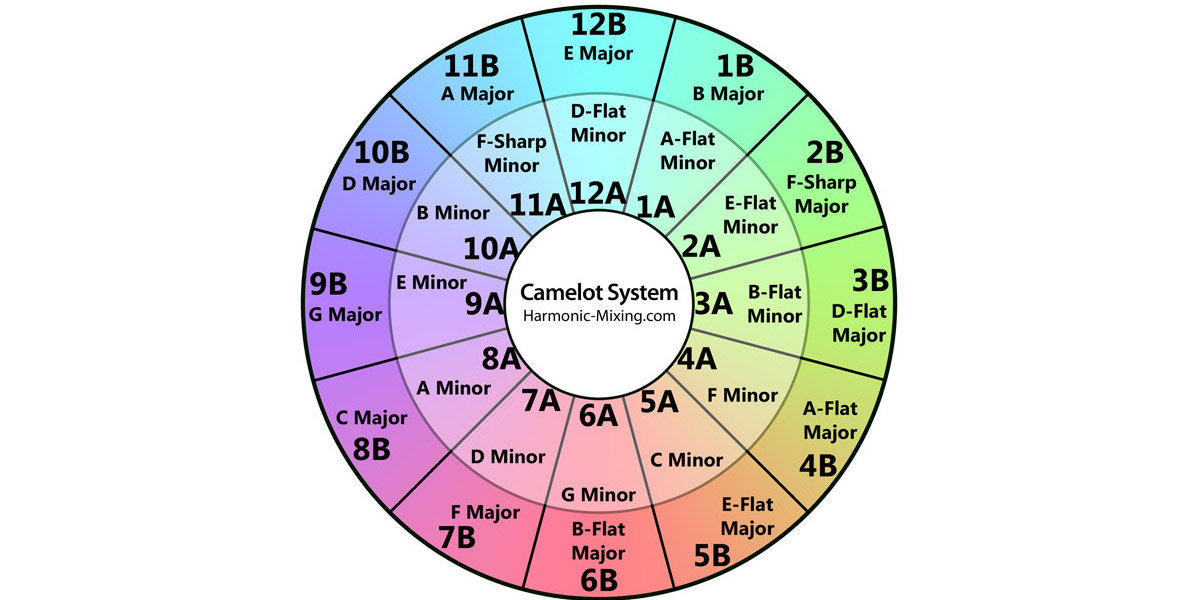
Now, as there are 24 possible musical keys in this system, and this “new rule” means you are able to mix between six of them, something cool becomes possible: By moving any song up a note, up two notes, down a note, or down two notes, it can potentially be mixed harmonically into any other song.
And that’s what the new Key Sync button does on the CDJ-3000s – it will move the new song up or down by one or two notes, and always find a match with the current song, because it follows the “revised” rules.
It’s awesome, and I am glad Pioneer DJ had done it this way – I hope the others follow. Now, Pioneer DJ also needs to switch the way compatible keys are calculated in the Filter options of the unit to follow its own logic, because weirdly they still follow the old way of doing things.
(Now, to be clear, a two-note key shift in either direction can make a song sound mighty weird, especially – for instance – well-known vocals, so use with care, but it’s a great development.)
You can key shift manually too, by hitting “Key Shift” on the screen, which brings up three buttons, an up, down and a reset, so for instance you can key shift live in the mix for creative purposes using these buttons.
One thing I couldn’t manage to achieve on testing, though, was switch out the key system nomenclature entirely. In Rekordbox, you can set your preferred key system to, say, Camelot (which most DJs use), and these key values are faithfully brought across into track information, so you see “8A”, “5B” etc in your lists. But elsewhere, the CDJ-3000 still uses C, Am, Eb and so on. Pioneer DJ says this will be a Rekordbox-selectable option on launch, though.
Sound quality & spec jumps
Pioneer DJ is making a big thing of the sound quality, claiming the best DAC in any DJ gear. Certainly in our experience with the unit it sounded amazing, and the improvements to the processing power in the unit directly affect this, especially when key shifting and key syncing.
I spoke to our tutor James Hype about this, and I wanted to know what he thought because I know that he carefully prepares pre-key shifted DJing tools in Ableton for his sets. James in particular key shifts a lot of acapellas, and he says they sound good – and knowing the time he spends trying to get his acapellas right in audio processing software, that’s praise indeed.
The Ethernet (“Pro Link” in Pioneer DJ talk) is now gigabit, which allows up to six players to join a Pro Link network.
Conclusion

So, these have been a LONG time in the coming, and with expectations so high, do they meet them?
Well, broadly – yes. To use these is to love them. I defy anyone not to enjoy the experience. No, they may not look like a huge leap forward on paper, but to DJ with, it’s no contest. They cost basically the same as their predecessor, and you’ll never want to go back to CDJ-2000NXS2s having used these.
Pioneer DJ has made a big thing about the fact that they are now MPU-based; in other words, they have a computer inside, and a powerful one at that, with a two-core and a four-core ARM processor. Currently, though, those processors seem pretty under-utilised.
Sure, the audio engine is sweeter than ever, and sure, there is some clever real-time key sync action going on, and that smooth screen needs a bit of processor power to do its thing, but…
I mean, look at the Denon DJ SC6000 – on paper, now an under-powered unit against the CDJ-3000, processor-wise. It can play two music sources at once. It’s got a better 10″ touchscreen, with multi-gesture. It’s got built-in streaming services. It’s got built in WiFi. It can analyse tracks on the fly, so no need to run them through software beforehand to use the advanced feature like beat sync, key sync, multi-band waveforms and so on. It’s got a Dropbox cloud locker built-in.
Where are all of these things on the CDJ-3000?
Well, the lack of dual layer (two music sources) is frankly probably a commercial decision – any half-decent festival needs four CDJs and a mixer, for “four decks” – why would Pioneer DJ want to even introduce the option of only buying two? (Pioneer DJ says it is so as not to confuse DJs, though, and knowing how much “each household appliance is like a new science” to some DJs, Pioneer may have a point…)
Want gear help? Grab your free PDF: The Digital DJ Gear Buyer’s Guide
The lack of WiFi is curious though, because you can indeed use the CDJ-3000s with WiFi – if it is built in to a networked router. Maybe Pioneer DJ thinks the use case isn’t there, or if it is, clubs will provide it via a router, which is needed anyway to network players together. Or maybe it is indeed built in, and at a later firmware update, it will be enabled.
Having on-board track analysis again would on the face of it be a very good thing; maybe the reason this is not there at launch is that the software work needed to get it playing nicely with Rekordbox hasn’t been done yet, and Pioneer DJ wants to get it right before rolling the feature out.

But software features, like streaming services and Dropbox cloud locker? I believe this stuff is definitely coming. It can all be added via firmware updates, which is what the new MPU architecture gives the CDJ-3000s. Really, the MPU is the biggest leap forward about this unit.
Indeed, it feels to me that not to have many of these features there on the CDJ-3000 has been a deliberate ploy by Pioneer DJ, to make the CDJ-3000 very much an “evolution” of the CDJ-2000NXS2 rather than have it represent a “revolution”.
After all, what the target DJs for these units value above all is durability, dependability and reliability. These units need to be switched out for CDJ-2000NXS2 units in working clubs, bars and festivals, and often are likely to end up being used in the same set-up as older units. Continuity is key. Superstar DJs are a notoriously conservative bunch, tech wise.
Of the changes that have been made, really, few are likely to be in any way contentious, which is probably the most important thing for Pioneer DJ.
Learn to DJ with us: The Complete DJ Course
Dropping the CD slot makes sense, although there are bound to be people for whom it is a deal-breaker. But really, preparing your music on USB is not difficult, and burning your music to plastic to DJ with is long-winded in itself, and more archaic than ever in the 2020s.
The new position for the hot cues strikes us as quite smart, although will upset many for sure. But the state we’ve seen some old Pioneer CDJs in after years of club use shows that the areas that seem to get the most worn are to the left and right directly under the jogwheels – presumably because DJs tend to rest their hands there!
Keeping that part of the player “clean” and yet still offering eight full hot cues seems a good compromise to us – and continuing the theme of continuity, it won’t scare the target big-name DJs who really don’t want anything to change at all about their CDJs if possible, ever!
But let’s not forget something else here – there is also a big market for the CDJ-3000s that isn’t big-name DJs, clubs and festivals: The affluent hobbyist/part-time DJ. These are the people who have been traditionally most open to innovation, to software DJing, laptops and so on, but who will spend big money on gear if they like it.
This is the sector that realised years ago that controllers and laptops offer an ease of use and power not available in traditional media players aimed at clubs and festivals. DJing on controllers and laptops then switching to club gear feels like a major leap backwards, and hobby/part-time/event DJs rightfully have said, “So why should I?”
One of the biggest takeaways for us having DJed with the new CDJ-3000s for a while (we tested with the DJM-900NXS2) is that actually, many serious hobbyists and part-time DJs are also going to want to buy these. (Those who can afford them, of course – they are still hellishly expensive.)

The size and quality of the screens, the smoothness of the scrolling, the very Rekordbox-esque three-colour waveforms, the jogwheel centre display borrowed directly from Pioneer DJ’s own DDJ-1000 unit, and the advanced feature-set (beat and key sync, decent and easy to operate looping, proper hotcue layout, parallel waveforms, and so on…) mean that DJing on the CDJ-3000s is pretty similar to DJing on software and controllers now.
Indeed, the things Pioneer DJ has always done well on its CDJs – I’ve always loved Track Filter for finding the next song, for instance – coupled with genuine innovation (Touch Cue and Touch Review are cool, and the new take on key sync is a bold and clever move), actually make DJing on the CDJ-3000s exciting – something I’ve not been able to say about Pioneer media players for a long time.
Now of course Denon DJ stole a pretty big lead on Pioneer DJ in the technology stakes when it comes to this type of player, with its SC5000 and SC5000M, and now the SC6000 and SC6000M. And as I mentioned above, Denon DJ’s players still have a whole host of features lacking in Pioneer DJ’s.
But Pioneer DJ does have a few things of its own that it does better: I love skipping ahead to hear what’s going to happen in a track, even on another player, in my headphones), plus the new Key Sync function is better on Pioneer DJ’s units than on Denon DJ’s. (And Denon DJ needs to make its Slip and Loop Move functions work as everyone else’s does, including those on the CDJ-3000.)

The traditional narrative has it that Denon DJ is gunning for the sector Pioneer DJ dominates (pros playing at clubs and festivals), and that unless Pioneer DJ sorts its act out, they’ll get ’em.
DJs who want cloud locker, dual layers, built-in streaming services and the like will prefer the Denon DJ players. DJs who have a choice (either because they are big enough to do so, or because they run or work for event companies who supply all their own gear to gigs anyway) likewise may still choose the more feature-rich Denon DJ gear.
Read this next: What DJ Gear Is Worth Spending Extra Money On?
What Pioneer DJ has (largely successfully) done here is not rock the boat too much, make something that is seriously much nicer to DJ on than before, thrown in a few well-considered new features (many from the XDJ player range), and future proof it all for juicy upgrades down-the-line by switching to MPUs inside. And so in our view, the new CDJ-3000 provides more than enough to keep the target market satisfied for the next five years.
Now, Pioneer DJ, please get some of those obvious features incorporated that you know you can (we want cloud locker, and streaming please!), launch a new mixer with a built in Ethernet/Pro DJ Link hub to save the need for an external clunky hub, and furthermore, surprise us with stuff we haven’t thought of – you’ve now got the platform to do just that!
Want help choosing gear? Grab your free PDF: The Digital DJ Gear Buyer’s Guide

